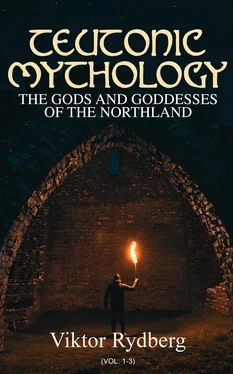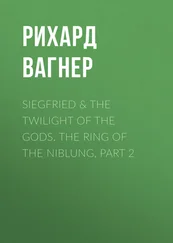vafermists. In its capacity of discharger of the thunder-cloud, the tank is called Eikthyrnir , the oak-stinger. Oaks struck by lightning is no unusual occurrence. The oak is, according to popular belief based on observation, that tree which the lightning most frequently strikes.
But Asgard is not the only citadel which is surrounded by vafermists. These are also found enveloping the home where dwelt the storm-giant Gymer and the storm-giantess Aurboda, the sorceress who knows all of Asgard's secrets, at the time when Frey sent Skirner to ask for the hand of their daughter Gerd. Epics which in their present form date from Christian times make vaferflames burn around castles, where goddesses, pricked by sleep-thorns, are slumbering. This is a belief of a later age.
To get over or through the vaferflame is, according to the myth, impossible for anyone who has not got a certain mythical horse to ride—probably Sleipner, the eight-footed steed of the Asa-father, which is the best of all horses (Grimn., 44). The quality of this steed, which enables it to bear its rider unscathed through the vaferflame, makes it indespensable when this obstacle is to be overcome. When Skirner is to go on Frey's journey of courtship to Gerd, he asks for that purpose mar thann er mic um myrckvan beri visan vafrloga , and is allowed to ride it on and for the journey (Skirn., 8, 9). This horse must accordingly have been in the possession of the Vans when they conquered Asgard, an assumption confirmed by what is to be stated below. (In the great epic Sigurd's horse Grane is made to inherit the qualities of this divine horse.)
On the outer side of the Asgard river, and directly opposite the Asgard gate, lie projecting ramparts ( forgardir ) to protect the drawbridge, which from the opening in the wall can be dropped down across the river (see below). When Svipdag proceeded toward Menglad's abode in Asgard, he first came to this forgardir (Fjöls., i. 3). There he is hailed by the watch of the citadel, and thence he gets a glimpse over the gate of all the glorious things which are hid behind the high walls of the citadel.
Outside the river Asgard has fields with groves and woods (Younger Edda, 136, 210).
Of the events of the wars waged around Asgard, the mythic fragments, which the Icelandic records have preserved, give us but very little information, though they must have been favourite themes for the heathen skaldic art, which here had an opportunity of describing in a characteristic manner all the gods involved, and of picturing not only their various characters, but also their various weapons, equipments, and horses. In regard to the weapons of attack we must remember that Thor at the outbreak of the conflict is deprived of the assistance of his splendid hammer: it has been broken by Svipdag's sword of victory (see Nos. 101, 103)—a point which it was necessary for the myth to assume, otherwise the Vans could hardly he represented as conquerors. Nor do the Vans have the above-mentioned sword at their disposal: it is already in the power of Gymer and Aurboda. The irresistible weapons which in a purely mechanical manner would have decided the issue of the war, were disposed of in advance in order that the persons themselves, with their varied warlike qualities, might get to the foreground and decide the fate of the conflict by heroism or prudence, by prescient wisdom or by blind daring. In this war the Vans have particularly distinguished themselves by wise and well calculated strategies. This we learn from Völuspa, where it makes the final victors conquer Asgard through vígspá , that is, foreknowledge applied to warlike ends (str. 26). The Asas, as we might expect from Odin's brave sons, have especially distinguished themselves by their strength and courage. A record of this is found in the words of Thorbjorn Disarskald (Younger Edda, 256).
Thórr hefir Yggs med árum
Ásgard of threk vardan.
"Thor with Odin's clan-men defended Asgard with indomitable courage."
But in number they must have been far inferior to their foes. Simply the circumstance that Odin and his men had to confine themselves to the defence of Asgard shows that nearly all other divinities of various ranks had allied themselves with his enemies. The ruler of the lower world (Mimer) and Honer are the only ones of whom it can be said that they remained faithful to Odin; and if we can trust the Heimskringla tradition, which is related as history and greatly corrupted, then Mimer lost his life in an effort at mediation between the contending gods, while he and Honer were held as hostages among the Vans (Ynglingas., ch. 4). Asgard was at length conquered. Völuspa, str. 25, relates the final catastrophe:
| brotin var bordvegr borgar asa knatto vanir vigspa vollo sporna. |
Broken was the bulwark of the asaburg; Through warlike prudence were the Vans able its fields to tread. |
Völuspa's words seem to indicate that the Vans took Asgard by strategy; and this is confirmed by a source which shall be quoted below. But to carry out the plan which chiefly involved the finding of means for crossing the vaferflames kindled around the citadel and for opening the gates of Asgard, not only cunning but also courage was required. The myth has given the honour of this undertaking to Njord, the clan-chief of the Vans and the commander of their forces. This is clear from the above-quoted passage: Njordr klauf Herjans hurdir —"Njord broke Odin's doors open," which should be compared with the poetical paraphrase for battle-axe: Gauts megin-hurdar galli —"the destroyer of Odin's great gate,"—a paraphrase that indicates that Njord burst the Asgard gate open with the battle-axe. The conclusion which must be drawn from these utterances is confirmed by an account with which the sixth book of Saxo begins, and which doubtless is a fragment of the myth concerning the conquest of Asgard by the Vans corrupted and told as history.
The event is transferred by Saxo to the reign of King Fridlevus II. It should here be remarked that every important statement made by Saxo about this Fridlevus, on a closer examination, is found to be taken from the myth concerning Njord.
There were at that time twelve brothers, says Saxo, distinguished for courage, strength, and fine physical appearance. They were "widely celebrated for gigantic triumphs." To their trophies and riches many peoples had paid tribute. But the source from which Saxo received information in regard to Fridlevus' conflict with them did not mention more than seven of these twelve, and of these seven Saxo gives the names. They are called Bjorn, Asbjorn, Gunbjorn, &c. In all the names is found the epithet of the Asa-god Bjorn.
The brothers had had allies, says Saxo further, but at the point when the story begins they had been abandoned by them, and on this account they had been obliged to confine themselves on an island surrounded by a most violent stream which fell from the brow of a very high rock, and the whole surface of which glittered with raging foam. The island was fortified by a very high wall ( præaltum vallum ), in which was built a remarkable gate. It was so built that the hinges were placed near the ground between the sides of the opening in the wall, so that the gate turning thereon could, by a movement regulated by chains, be lowered and form a bridge across the stream.
Thus the gate is, at the same time, a drawbridge of that kind with which the Germans became acquainted during the war with the Romans already before the time of Tacitus (cp. Annal. , iv. 51, with iv. 47). Within the fortification there was a most strange horse, and also a remarkably strong dog, which formerly had watched the herds of the giant Offotes. The horse was celebrated for his size and speed, and it was the only steed with which it was possible for a rider to cross the raging stream around the island fortress.
Читать дальше











